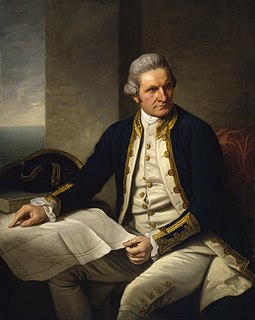
The Republic of Fiji Military Forces (RFMF) is the military force of the Pacific island nation of Fiji. With a total manpower of 3,500 active soldiers and 6,000 reservists, it is one of the smallest militaries in the world, though most of its surrounding island nations have no militaries at all. The Ground Force is organised into six infantry and one engineer battalions, with approximately 6,000 reserves. There was formerly one "Zulu" company of counter-revolutionary specialists, which was deactivated in late 2000 due to a mutiny by some of its members.

The United States Fleet Forces Command (USFF) is a service component command of the United States Navy that provides naval forces to a wide variety of U.S. forces. The naval resources may be allocated to Combatant Commanders such as United States Northern Command (USNORTHCOM) under the authority of the Secretary of Defense. Originally formed as United States Atlantic Fleet (USLANTFLT) in 1906, it has been an integral part of the defense of the United States of America since the early 20th century. In 2002, the Fleet comprised over 118,000 Navy and Marine Corps personnel serving on 186 ships and in 1,300 aircraft, with an area of responsibility ranging over most of the Atlantic Ocean from the North Pole to the South Pole, the Caribbean Sea, Gulf of Mexico, and the waters of the Pacific Ocean along the coasts of Central and South America. The command is based at Naval Support Activity Hampton Roads in Norfolk, Virginia and is the navy's service component to U.S. Northern Command and is the Joint Functional Maritime Component Command under the U.S. Strategic Command.
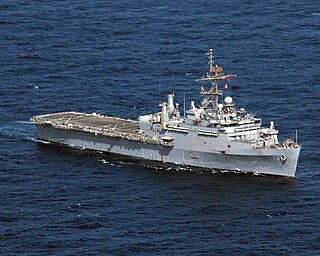
USS Nashville (LPD-13), an Austin-class amphibious transport dock, was the third ship of the United States Navy to be named for the capital city of Tennessee. Her keel was laid down on 14 March 1966 by the Lockheed Shipbuilding and Construction Company of Seattle, Washington. She was launched on 7 October 1967 sponsored by Mrs. Roy L. Johnson, and commissioned at Puget Sound Naval Shipyard, Bremerton, Washington, on 14 February 1970 with Captain Frank R. Fahland in command.

The Seventh Fleet is a numbered fleet of the United States Navy. It is headquartered at U.S. Fleet Activities Yokosuka, in Yokosuka, Kanagawa Prefecture, Japan. It is part of the United States Pacific Fleet. At present, it is the largest of the forward-deployed U.S. fleets, with 60 to 70 ships, 300 aircraft and 40,000 Navy and Marine Corps personnel. Its principal responsibilities are to provide joint command in natural disaster or military operations and operational command of all naval forces in the region.

Vice Admiral Sir Humphrey Thomas Walwyn, was an officer of the Royal Navy, who served during the Second Boer War and First World War, and was the Commander-in-Chief of the Royal Indian Navy from 1928 until his retirement in 1934. He then served as Governor of Newfoundland from 1936, throughout the Second World War, until 1946.
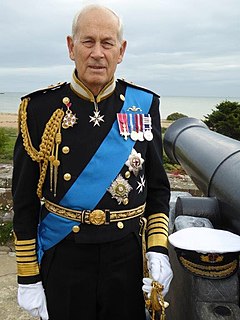
Admiral of the Fleet Michael Cecil Boyce, Baron Boyce, is a retired Royal Navy officer who now sits as a crossbench member of the House of Lords.

The British Mediterranean Fleet also known as the Mediterranean Station was part of the Royal Navy. The Fleet was one of the most prestigious commands in the navy for the majority of its history, defending the vital sea link between the United Kingdom and the majority of the British Empire in the Eastern Hemisphere. The first Commander-in-Chief for the Mediterranean Fleet was the appointment of General at Sea Robert Blake in September 1654 the Fleet was in existence until 1967.

Gary Roughead is a former United States Navy officer who served as the 29th Chief of Naval Operations from September 29, 2007 to September 22, 2011. He previously served as Commander, United States Fleet Forces Command, from May 17 to September 29, 2007. Prior to that, Roughead served as the 31st Commander, United States Pacific Fleet from July 8, 2005, to May 8, 2007. He retired from the U.S. Navy after 38 years of service.

A carrier strike group (CSG) is an operational formation of the United States Navy. It is composed of roughly 7,500 personnel, an aircraft carrier, at least one cruiser, a destroyer squadron of at least two destroyers or frigates, and a carrier air wing of 65 to 70 aircraft. A carrier strike group also, on occasion, includes submarines, attached logistics ships and a supply ship. The carrier strike group commander operationally reports to the commander of the numbered fleet, who is operationally responsible for the area of waters in which the carrier strike group is operating.

U.S. Naval Forces Southern Command is the naval element of United States Southern Command (USSOUTHCOM). Its areas of operation include South America, Central America, the Caribbean and surrounding waters. Its headquarters are located at Naval Station Mayport, Florida. USNAVSO is currently under the command of Rear Admiral Sean S. Buck.
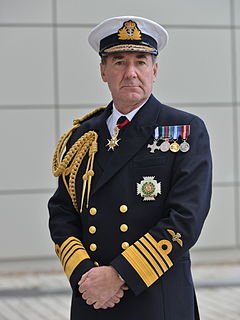
Admiral Sir George Michael Zambellas, is a retired Royal Navy officer. He was the First Sea Lord and Chief of the Naval Staff from April 2013 until he handed over duties to Admiral Sir Philip Jones in April 2016.
Lieutenant is a commissioned officer rank in many nations' navies. It is typically the most senior of junior officer ranks. In most navies, the rank's insignia may consist of two medium gold braid stripes, the uppermost stripe featuring an executive curl in many Commonwealth of Nations; or three stripes of equal or unequal width.

Admiral Sir Philip Andrew Jones, is a retired former senior Royal Navy officer. After service in the South Atlantic in 1982 during the Falklands War, he commanded the frigates HMS Beaver and HMS Coventry. He went on to be Flag Officer, Scotland, Northern England and Northern Ireland, Commander United Kingdom Maritime Forces and Assistant Chief of the Naval Staff before being appointed Fleet Commander and Deputy Chief of the Naval Staff. Jones served as First Sea Lord from April 2016 to June 2019.
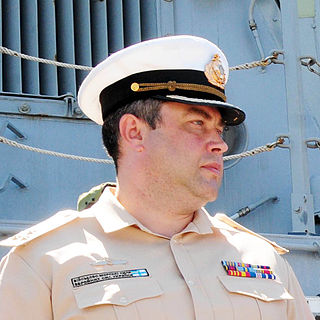
Denis Valentinovich Berezovsky is a rear admiral and the Russian Black Sea Fleet deputy commander. He is also a former commander of the Ukrainian Navy. He was appointed commander-in-chief of the Ukrainian Navy by Interim President Oleksandr Turchynov on March 1, 2014, serving for just one day before defecting to the self-declared pro-Russian separatist Crimean government during the 2014 Crimean crisis. On March 24, 2014, the Defense Minister of Russia Sergei Shoigu appointed Berezovsky as the Russian Black Sea Fleet deputy commander. On March 5, 2014, the Office of the General Prosecutor of Ukraine issued an order to detain Berezovsky on suspicion of treason.
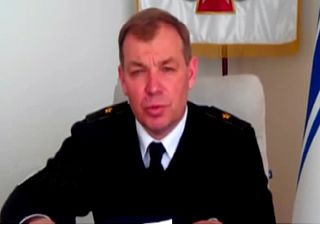
Serhiy Anatolyovich Hayduk is a Ukrainian Vice Admiral and a former commander of the Ukrainian Navy.
Admiral H. C. A. C. Thisera VSV, USP, ndc was the 14th Commander of the Sri Lankan Navy. He was appointed on 28 January 1997 until 31 December 2000. He was succeeded by Daya Sandagiri.
Admiral D. A. M. R. Samarasekara VSV, USP was the 13th Commander of the Sri Lankan Navy. He was appointed on 16 November 1992 until 27 November 1997. He was succeeded by H. C. A. C. Thisera.
Admiral H. A. Silva VSV, ndc, psc was the 11th Commander of the Sri Lankan Navy. He was appointed on 1 November 1986 until 31 October 1991. He was succeeded by Clancy Fernando.
Rear Admiral D. V. Hunter (1917-19??) was Sri Lankan admiral. He served as the 7th Commander of the Sri Lankan Navy.
Captain W. E. Banks CBE, DSC was the first Commander of the Royal Ceylon Navy. He was appointed on 2 December 1950 until 25 November 1951. He was succeeded by J. R. S. Brown.
